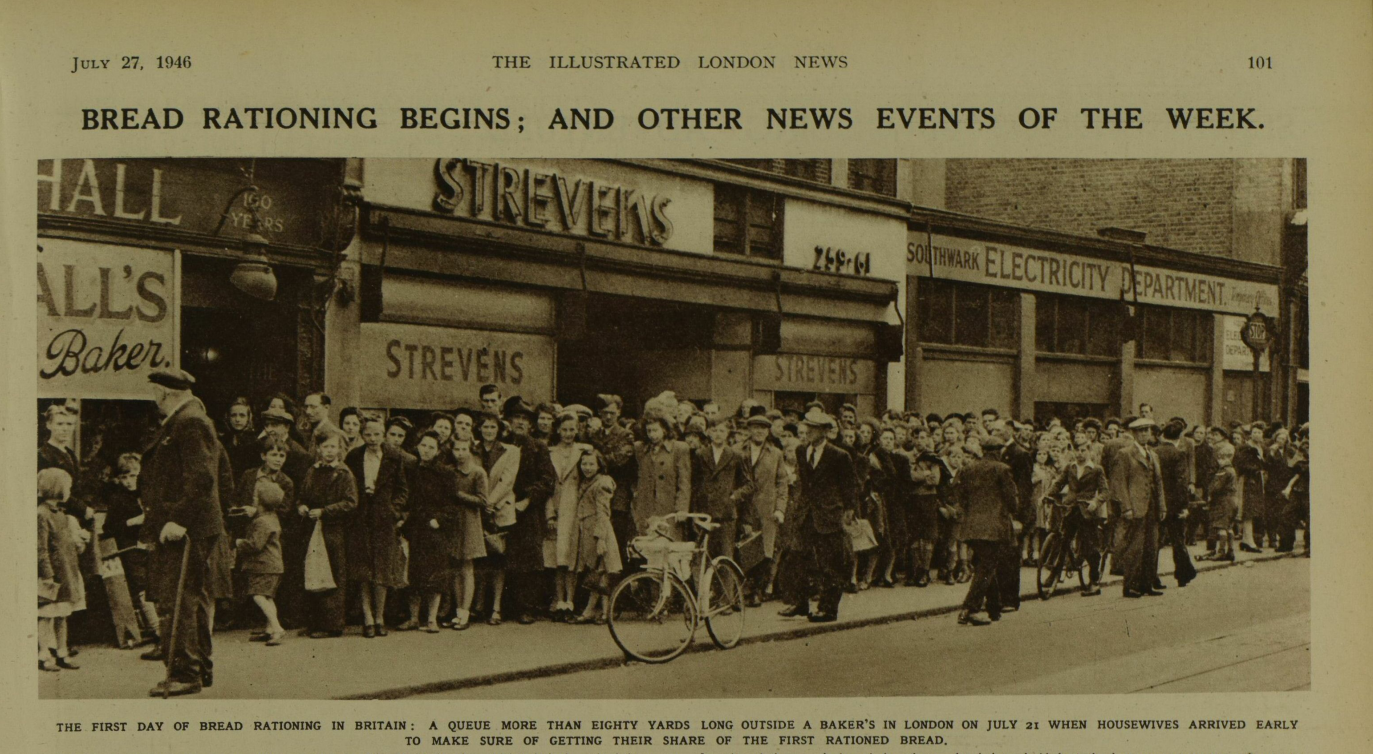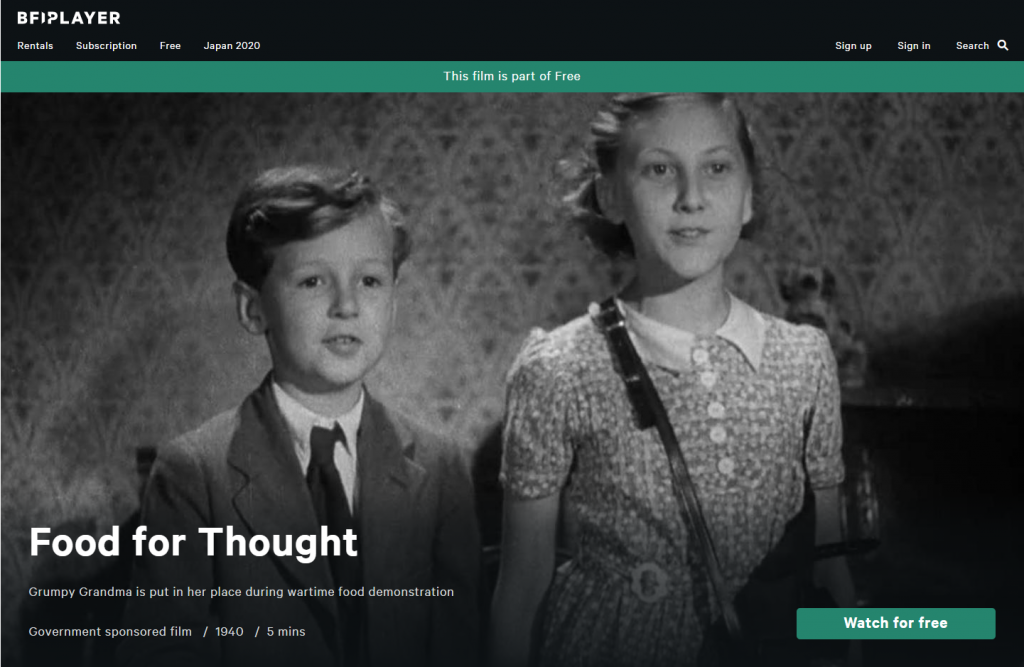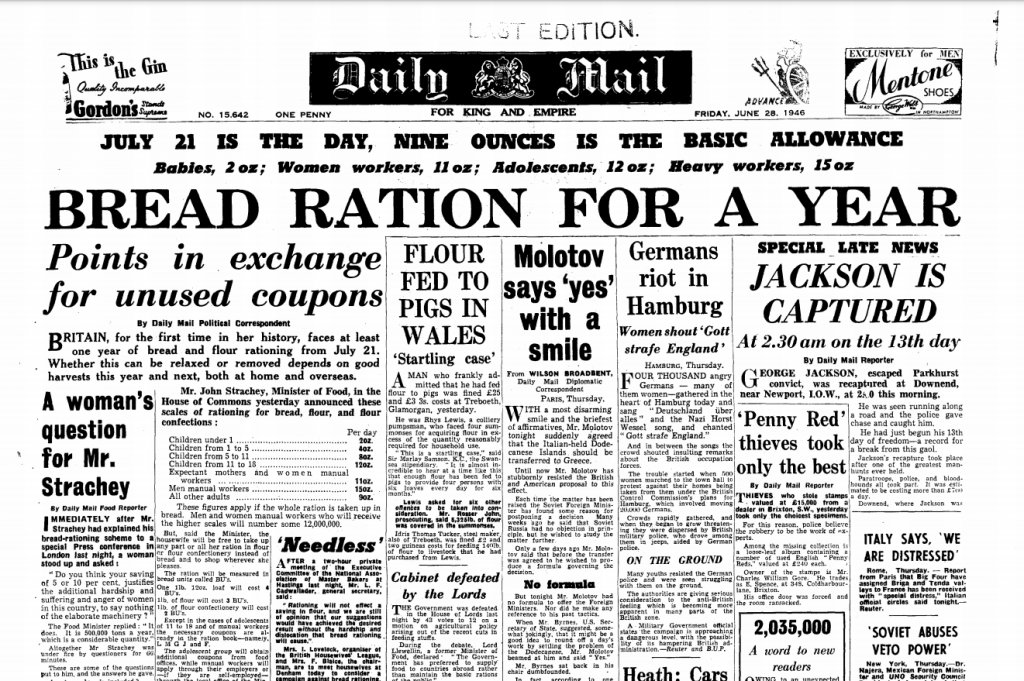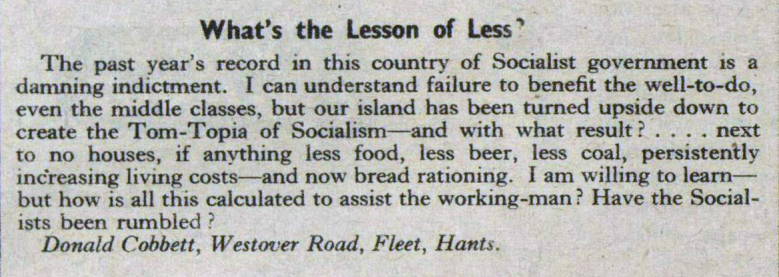Today’s post, highlighting the wide range of newspaper archive databases the Library has and how these can be used to research a particular topic or event, is written by Louise Peterkin, Helpdesk Assistant, University of Edinburgh Libraries. During lockdown Louise also worked part-time with the Library Academic Support team.
I was delighted to be asked to write a blog showcasing the University’s wide range of databases and primary sources. These have been bolstered considerably in the last few months with the exciting addition of 365 new databases through our new ProQuest 350 Access subscription.
Looking for inspiration as to what to write about I searched Google for important events in history that fell between July and August. 22 July 1946 – Bread rationed for the first time in the UK leapt out at me. I always thought bread had been rationed during World War 2? I was keen to find out more.

Screenshot of “Bread Rationing Begins; and Other News Events of the Week.” Illustrated London News, July 27, 1946, 101. The Illustrated London News Historical Archive, 1842-2003.
I researched the topic through the University’s databases, starting with our newspaper archives. We have access to ProQuest Historical Newspapers, which includes access to The Guardian (1821-2003), The Observer (1791-2003) and The Scotsman (1817 -1950) and Gale Primary Sources and Gale News Vault which contain access to many historical newspapers including to the Daily Mail Historical Archive (1896-2004) and Times Digital Archive (1785 to 2011).
I have listed all of the resources I used in the Notes section at the end of the blog.
A renewed interest in home baking during lockdown
During the early stages of the Covid-19 pandemic, anxiety over potential shortages of basic provisions incited a brief spate of panic buying. Throughout the UK supermarkets shelves proved to be consistently empty of the same staples: toilet paper, hand sanitizer and wipes, pasta. Around the same time, I saw an increasing amount of examples of home baking waft into my twitter feed. Every day – new photos of lemon drizzle triumphs or sunken sponge disasters; the phrase “sourdough starter” nudged its way into the collective vocabulary of a society in lockdown. After a while the loo roll and packets of penne were back in the shops but another staple started to prove elusive: flour.
An article from The Sunday Times, this May, reports on how a watermill in County Meath, Ireland, after having been in the same family since 1859, saw its wholemeal flour production double during lockdown. The proprietor of the Martry Mill, James Tallon states, “I used to hear my father talking about the Second World War and how they worked 24 hours a day to keep the supply going. I always took that story with a pinch of salt, but I found that with the arrival of the pandemic, history is repeating itself. We’re grinding flour at those same levels” He goes onto say “Before the pandemic, a lot of people weren’t baking at all. People were living very fast lives and running here, there and everywhere. It’s a whole different scenario now, with people at home having nothing to do. Baking seems to be one of the therapeutic things they’ve taken to”. 1.
It can’t be denied that many people in lockdown found themselves with a great deal more time on their hands. But it could also be contended that different factors converged to renew the interest in baking. The enforced shrinking of people’s lives to the domestic sphere combined with a growing climate of unease over the economy perhaps reawakened preoccupations and sensibilities that were linked to a bygone age; notions of frugality, resourcefulness and self-sustenance. Moreover, it could say something deeper about people’s desire for greater autonomy in uncertain times. I like Zoe Williams take on this in The Guardian: “Bread-making has become our port in the storm. With the world turbulent, unpredictable and, above all else, outside our control, baking loaves has become not only an act of self-sufficiency, but also one of agency: you are creating a place where the old rules still work” 2.
Rationing during World War 2
On September 3, 1939, Prime Minister Neville Chamberlain announced that Britain was at war with Germany. Prior to World War 2, Britain was importing approximately 20 million (long) tons of its food supplies from overseas. To ensure equal distribution of supplies and to counter the ongoing threat of German submarines attacking merchant ships, the Ministry of Food introduced a system of rationing. Every person in Britain (including children) were issued with a ration book and coupons and had to register with specific shops to use the coupons in exchange for provisions. On 8 January, 1940, UK citizens were advised “Rationing begins today. Everyone holding a general of a child’s ration book should have registered with a retailer for bacon and ham, butter sugar and meat. Meat rationing does not begin at once, but you must register for meat now.”3.

4. Screenshot from ‘The Scotsman (1921-1950); Jan 8, 1940; ProQuest Historical Newspapers: The Scotsman, pg. 5.
Further incremental rationing followed of meat, tea, jam, biscuits, breakfast cereals, cheese, eggs, lard, milk, canned and dried fruit.
From 1940 to 1943, Frederick James Marquis, better known as Lord Woolton served as Minister of Food. During that time, in addition to introducing rationing and free school meals, he architected a concentrated campaign to educate the nation about how to best utilize the limited provisions they had. He established Advice Centres all over the UK which offered free cookery tutorials and recipes leaflets tailored to the ration book larder. The Woolton Pie, a pastry dish which substituted potatoes and seasonal vegetables in place of meat became an emblem of war time austerity.

5. Screenshot from “Lord Woolton Pie.” Times, April 26, 1941, 2. The Times Digital Archive.
Public information films were made to instruct on the importance of a wholesome diet during rationing. There are lots of enjoyable archive footage to be found for free the BFI Player. I particularly like this film clip instructing people on the best foodstuffs to obtain vitamins from and wasn’t surprised to learn it was a collaboration between The Ministry of Food and Ealing studios – I kept expecting Alec Guinness to pop up as an irascible aunt! 6.

6. Food for Thought – https://player.bfi.org.uk/free/film/watch-food-for-thought-1940-online
Dig for Victory
Fruit and vegetables were not rationed during the war but they were in short supply. The majority of public land such as ornamental gardens and lawns was commandeered for the cultivation of produce and the nation was encouraged to start growing their own food. In 1939, just after the outbreak of war Reginald Dorman-Smith, the Minister of Agriculture at the time made the following appeal: “While we could rely on the Navy to keep trade routes open, and while we would still be able to draw on food supplies from overseas, those supplies might not always be unlimited. Half a million more allotments would provide potatoes and vegetables to feed another million adults and one and a half million children for eight months out of twelve. “I appeal to you all – dig, cultivate, plant and sow”. 7.
The government were keen to stress the benefits the public growing their own produce in gardens and allotments. It would supplement their rations, boost the nutritional content of their diets and mitigate the demand put on supply ships. “The wolf is not yet at our door, but every time a food ship is sunk upon the high seas, he comes nearer”. 8.
In 1940, the campaign, dubbed Dig for Victory gained momentum and the new Minister of Agriculture, R. S. Hudson, announced “Vegetables produced in private gardens and allotments cannot be seriously affected by enemy action and it is in the national interest to make the domestic vegetable supply as large as possible. All who can wield spade and hoe are urged to make this valuable contribution towards winning the war.” 9

10. Screenshot from “Dig for Victory now!” Picture Post, December 6, 1941, 2. Picture Post Historical Archive, 1938-1957.
The campaign was successful; its missive repeated in parliamentary speeches and carefully chosen sound bites and slogans, in vivid posters and newspaper advertisements. By 1943 the number of allotments in Britain had almost doubled to 1,400,000. While the propaganda had a pragmatic aim, its underlying objective of emphasising the role the individual in the war effort helped to boost the nation’s morale. Looking through many articles and advertisements for Dig for Victory, it isn’t hard to notice that the terminology veered towards the militarist – garden tools were to be “wielded” like weapons, citizens and residential areas “armed” with allotments. All this went towards making people feel like they were doing their bit, working together and fighting the war from their own back garden.
The National Loaf
Contrary to what some might have thought (i.e. me!), bread was never rationed in Britain during WW2. The government thought that the restriction of a basic such as daily bread would be somewhat of a step too far in the diminishing of the nation’s morale. However measures were needed to counter the demands for wheat being brought in from Canada as “of the many imported foods there was nothing which was bulked so large as wheat. Therefore to reduce the tonnage for the transport of wheat the Government had decided to increase to 85 percent the ration of flour from wheat milled in this country.” 11
So in the autumn of 1942, national flour or “wheat meal flour” was introduced. Bakers were banned from using white flour and could only make the national loaf, a governmentally demarcated bread made from the new regulation flour. The national flour extracted 85 percent more of the hulled wheat grain. Making the grain of the bread go further and decreasing the demand for imported wheat. The flour made for a more fibrous, healthier loaf and held “6 per cent more protein, nearly three times more vitamin B1 and twice as much iron” as white flour “12. It was fortified with additional nutrients which made the bread “undoubtedly rich in the whole of the vitamin-B complex and especially valuable as a source of nicotinic acid” 13.
Yet, despite its necessity and dietary advantages, there was one undisputable downside to the new loaf: its unappetizing colour and chewy texture. So disliked was the bread that it was nicknamed “Hitler’s secret weapon” in some quarters! The fun, informative blog thewartime.kitchen.com describes how the new loaf was hard sell to the dubious public.
“Nutritionists praised the bread as it had added calcium and vitamins, but it dried out very quickly. The bread was grey, coarse, had a crumby texture almost like sawdust, contained a lot of salt so it would “keep” longer, and was dry. It was stale one day after baking, had a chewy crust that was tough, and some would dip it in water to add some moisture. 14.
A fantastic resource recently acquired by the University as part of the ProQuest 350 subscription is British and Irish Women’s Letters and Diaries. It holds 400 years of personal writings of women from over the UK. It really brings history alive as it documents the thoughts and experiences of real people as they are living through a time in history. In the diaries of Iris M Bullen, an English woman in her twenties during World War 2, I found a lacklustre review of the national loaf from 1942. 15
Tuesday September 3rd
Went to town the afternoon with Monica. Our bread now is composed of potatoes & flour and has to be 24 hours old before delivery. It is inclined to be heavy and sour.
“Heavy and sour” … maybe that’s why the judges of the National Loaf competition 1942, reported on in an article in an article in the Guardian at the time, seemed to do everything in their deliberations apart from taste the stuff!
Housewives will be disappointed to learn that the judges for the national loaf competition, taking place at the Caxton Hall on November 18, will not actually taste the bread. They will squeeze each loaf to let the gases escape by that can form 50 per cent of their judgement. They will cut it and half and smell it, examine it with the eye” 16.
Mmmm, nothing like the smell of gasses escaping from a government standardised loaf!
The British Cartoon Archive contains over 140,000 cartoons and caricatures. I found this one by Joseph Lee from the Evening News, 1942.

17. Smiling Through That Wholemeal Feeling, Jasper Lee. April 18, 1942. British Cartoon Archive (JL2082).
The text reads Smiling through That Wholemeal Feeling / “Oh yes, I get along very well with the National bread and oh, by the way … here’s your garden roller.”
When looking at archive cartoons I often feel that an appreciation of the humour gets lost in the translation of time, similar to when your high school history teacher would almost do himself an injury laughing at a Punch cartoon in front of the blank faced and baffled class! Is the neighbour throwing the garden roller out of ire at the poor quality of the bread? Or is it a testament to the strength-giving properties of the new loaf? Answers on a postcard please!
The National Loaf was discontinued in 1956.
July 21, 1946 – Bread is rationed for the first time in Britain
“Ne vous mêlez pas du pain” – Turgot
Though the war ended in 1945 rationing continued in Britain for a further nine years to sustain an economy ravaged by war. On 21 July 1946, the Labour government introduced the rationing of bread, flour and flour confectionery. It was a policy which would last two years until July 1948.
The blow to the national morale was considerable. “The decision to ration bread is an historic one for this country. We were near to rationing in the spring of 1918; the plan was ready and the spares in the ration card prepared. We came near to it during the late war, especially when the submarine attacks were at their worst. It is profound irony that it should be in the year of peace and recovery that we have to accept this new hardship” 18. It provoked an outcry from the public and from the opposing Conservative government, who deemed it needlessly austere and inefficient. The system for bread rationing was criticised as being overly complicated. This screenshot from The Daily Mail details the scale of bread rationing shows the intricacy of the system with its various dispensations and system of bread unit measuring.

19. Screenshot of front page of The Daily Mail, June 28, 1946. Daily Mail Historical Archive.
Notice how the screenshot also captures a small related article entitled “Needless”; it was the opinion of the British Housewife’s League that amount of flour stocks that bread rationing would save would not justify the privation it would cause. The League started to campaign against bread rationing in earnest in July 1946, “A resolution demanding the bread rationing and further cuts in foodstuffs should not be proceeded with, and that a public inquiry into the country’s food situation be instituted was passed at a meeting organized by the British Housewifes’ League at Central Hall, Westminster yesterday; A vote of no confidence in the present Governments food policy was also passed” 20.
Britain’s bread had already been altered with the introduction of the national loaf; now even that was being rationed. The founder of the League Mrs. Irene Lovelock argued “We have put up the loaf being made smaller, we have put up with it being made darker, but women say here and now that we won’t have bread rationing” 21.
The British Houswife’s League were successful in their protest to the extent it forced a more protracted explanation out of the government. In a public announcement film the Minister of Food, John Strachey defended the decision to ration bread, stating that stocks of wheat were so precarious that rationing was a judicious precaution against shortages caused by factors such as poor crops, or dock worker strikes. Strachey’s unyielding stance was that this was a circumspect, entirely essential move “Wouldn’t you agree that no government would dream of doing anything as unpopular as rationing bread … unless we come to the conclusion it was absolutely necessary as a safeguard to see that every family in this country was sure of its share…”
You can see clips from John Strachey’s explanation speech on the British Pathe webpage.

22. Screenshot from Food Minister Strachey Explains 1946, British Pathe.
Many people were angry at what they saw as government ineptitude in controlling wheat stocks. They believed if pre-emptive measures had been employed earlier there would not be need for a drastic response such as bread rationing. In an article in 1946, The Scotsman enumerated what they saw as the government’s failings in regards to crop management, highlighting their lack of foresight in ensuring enough provisions for livestock holders and failing to sow an adequate acreage of crops in winter and spring. “It is of interest to note that the amount of wheat Mr Strachey calculates will be saved by the introduction of bread rationing – 500,000 tons – is exactly equal to the extra quantity which would have been forthcoming had the acreage of British Wheat been stepped up as desired by the Opposition” 23
In the late 1940s the Conservative Party exploited the negative reaction to bread rationing to rally middle-class supporters against Labour. In Ina Zweiniger-Bargielowska’s comprehensive essay about the socio-political implications of the British bread ration she states “The issue helped to revive opposition to the government by focusing discontent on a specific policy. The campaign against bread rationing was waged by the Conservative Party in and out of Parliament, by the press as well as by housewives and bakers” 24 The following letter to the editor in the Picture Post in 1946 seems to support the view the bread rationing had instilled distrust in some working class citizens towards what they saw as the repercussions of the socialist leanings of the Labour government.

25. Screenshot of Cobbett, Donald. “‘What’s the Lesson of Less’.” Picture Post, vol. 32, no. 3, 20 July 1946, p. 4. Picture Post Historical Archive, 1938-1957.
On the 22 July 1948 an end to bread rationing was announced. John Strachey insisted that the rationing had been worthwhile and that in the last 12 months a saving of between 1000 and 2000 tons of wheat per week (approximately 6 percent. Winston Churchill, the leader of the Conservative party accused Strachey’s figures of being “foxed” (fudged) 26. Amongst the general public the mood was a mixture of relief and resentment over what was considered an ill-advised, unnecessary political manoeuvre. They were glad to see the back of it and outraged that it had happened in the first place. This snippet is from an article from The Gloucester Citizen, 22 July 1948 simply headed “Good Riddance”!
“For a considerable time past, it has been obvious that the rationing scheme for bread and flour was a complete farce. The system had very many weaknesses, and it added enormously to the everyday difficulties of the bakers and the housewives alike. For that reason alone, the decision of the Minister of Food to end this two-year- old restriction on Sunday is universally welcomed.”27.
It wouldn’t be until 4 July 1954, fourteen years after it was announced in Britain that rationing ended in full.
Conclusion
Researching this topic has been instructional to me both in finding out about a subject I knew little about and in finding my way round the various primary sources and databases the University subscribes to; discovering the best ways to refine my searches through key words and dates. I enjoyed the nuances within the topic – from “reading between the lines” in the difference in coverage in left or right leaning newspapers of the time or looking deeper into the socio-political reasons behind government strategies and war propaganda. I was struck by some of the resonances between the then and now – sensitivities and anxieties relating to ideas of both social distribution and self-sufficiency in food and welfare during the Second World War and the recent pandemic. Moreover, I came away with the magnitude of bread in the lives of daily people and the realisation that it was more than a basic food stuff it is an emblem of basic rights, civil liberties and dignity.
Louise Peterkin – Helpdesk Assistant and temporary Academic Support Librarian Assistant
Notes:
[These are basic notes and not all are full references so shouldn’t be directly copied but they should have enough information for you to find the original documents online.]
- The Sunday Times (London), May 10, 2020 Sunday, Edition 1, Ireland, Lexus Library News
- Grains of truth: what the flour shortage tells us about who we are, The Guardian Tue 14 Apr 2020
- Courier and advertiser (Dundee, Scotland), Monday, January 08, 1940; pg. 5; Issue 27018. from Gale News Vault
- Rationing quantities. (1940, Jan 08). The Scotsman (1921-1950) Retrieved from https://search-proquest-com.ezproxy.is.ed.ac.uk/docview/481587628?accountid=10673
- The Times (London, England), Saturday, Apr 26, 1941; pg. 2; Issue 48910, Gale News Vault
- https://player.bfi.org.uk/free/film/watch-food-for-thought-1940-online
- You Can Be a Farmer Now.” Western Times, 6 Oct. 1939, p. 4. British Library Newspapers,
- Johnston, Thomas, M. P. “Keeping the Wolf from the Door.” The Listener, vol. 23, no. 578, 8 Feb. 1940, p. 261+. The Listener Historical Archive, 1929-1991,
- .Dig For Victory.” Western Times, 22 Nov. 1940, p. 3. British Library Newspapers, Friday, Jan. 26, 1940, Daily Mail (London, England) Issue: 13652
- Dig for Victory now!” Picture Post, vol. 13, no. 10, 6 Dec. 1941, p. 2. Picture Post Historical Archive, 1938-1957
- THE WHITE LOAF TO DISAPPEAR: NATIONAL WHEATMEAL WHEN PRESENT FLOUR STOCKS ARE EXHAUSTED. (1942, Mar 12). The Manchester Guardian (1901-1959) Retrieved from https://search-proquest
- zzard, Percy W. D. “White Loaf Banned from Apl. 6.” Daily Mail [London, England] 12 Mar. 1942: 3. Daily Mail Historical Archive, 1896-2004. Web. 6 Sept. 2020.
- The Lancet, 1942, Vol.239 (6186), p.357-357 https://edin.ac/2QQbmrr .
- thewartime.kitchen.com
- Iris M. Bullen, 1914-; in A Record or Diary of an Anxious and Eventful Period In My Life (Alexandria, VA: Alexander Street, 2004), 1-255.”
- OUR, W. R. (1942, Nov 08). THE PERFECT LOAF: BLAMING THE BIN. The Observer (1901- 2003) https://edin.ac/34LLy7R
- https://archive.cartoons.ac.uk/GetMultimedia.ashx?db=Catalog&type=default&fname=JL2082.jpg
- https://www.theguardian.com/century/1940-1949/Story/0,,105118,00.html
- The Daily Mail, June 28, 1946. Daily Mail Historical Archive.
- Housewives’ Opposition To Bread Rationing. The Times (London, England),Tuesday, Jul 09, 1946; pg. 2; Issue 50498.
- Housewives’ Opposition To Bread Rationing. The Times (London, England),Tuesday, Jul 09, 1946; pg. 2; Issue 50498.
- British Pathe (https://www.britishpathe.com/video/food-minister-strachey-explains/query/bread+rationing)
- BREAD RATIONING. (1946, Jun 28). The Scotsman (1921-1950) Proquest Historical Newspapers
- INA ZWEINIGER-BARGIELOWSKA, Bread Rationing in Britain, July 1946–July 1948, Twentieth Century British History, Volume 4, Issue 1, 1993, Pages 57–85, https://doi-org.ezproxy.is.ed.ac.uk/10.1093/tcbh/4.1.57
- What’s the Lesson of Less’ Author: Donald CobbettDate: Saturday, July 20, 1946,Publication: Picture Post (London, England)
- BREAD RATIONING TO END ON SUNDAY: FLOUR DELIVERIES TO BE CONTROLLED. (1948, Jul 22). The Scotsman (1921-1950) Retrieved from https://search-proquest-com.ezproxy.is.ed.ac.uk/docview/482774478?accountid=10673
- “Good Riddance.” Gloucester Citizen, 22 July 1948, p. 4. British Library Newspapers, https://link-gale-com.ezproxy.is.ed.ac.uk/apps/doc/JF3232201727/GDCS?u=ed_itw&sid=GDCS&xid=41876ff4. Accessed 7 Sept. 2020.
